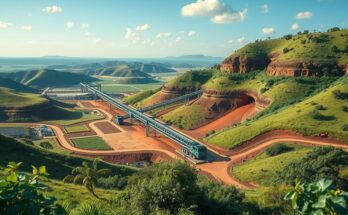Angola’s National Development Plan includes a $60 billion strategy for natural gas projects to bolster agriculture, enhance food security, and reduce fertilizer imports. The AOG conference will address investment in the gas sector. Key projects include a fertilizer production partnership and the Soyo II power plant, significantly increasing energy supply and local agricultural output.
The National Development Plan (NDP) 2023-2027 of Angola delineates a detailed strategy aimed at fortifying agricultural operations nationwide while enhancing food security. The implementation of substantial natural gas projects, projected to cost approximately $60 billion, will play a pivotal role in supporting agriculture by providing a cost-effective and reliable energy source.
The Angola Oil & Gas (AOG) conference scheduled for September 3-4 in Luanda will explore the strategic significance of investing in the country’s natural gas value chain. This event aims to unify upstream, midstream, and downstream stakeholders, facilitating discussions on power generation, fertilizer production, financial integration, and opportunities for value addition across sectors.
Currently, Angola imports fertilizer worth about $120 million each year to satisfy local agricultural demands. However, proposed projects harnessing natural gas for ammonia and urea production are expected to significantly reduce this dependency. Notably, in February 2025, Toyo Engineering Corporation partnered with Angolan fertilizer producer Amufert to employ its patented urea technology at the Soyo urea plant. With a daily capacity of 4,000 tons, this facility is set to operationalize in 2027, underpinned by a $1.4 billion commitment from the African Export-Import Bank, which aims to elevate local fertilizer production.
In addition to fertilizer production, natural gas is anticipated to improve access to consistent fuel supplies for agricultural operations in Angola, which predominantly rely on biomass and diesel. The distribution of liquefied petroleum gas (LPG) is on the rise, with plans for 1.3 million tons slated for the domestic market by Q4 2024. The first quarter of 2024 showed a 15% increase in LPG distribution, with a projected 31% uptick in demand by 2027. Sonangol, Angola’s national oil company, has expanded its gas-filling capacity in Cabinda, effectively increasing regional gas availability by 28%, thereby enhancing fuel security in agriculture.
Several forthcoming gas projects are set to elevate agricultural productivity. The Soyo II combined-cycle power plant, expected to generate 750 MW, will become operational in 2025, augmenting electricity access by 20%. The advancement of Angola’s initial non-associated gas initiative, comprising the Quiluma and Maboqueiro fields, is also underway, with the New Gas Consortium finishing offshore platforms ahead of schedule. This project aims to provide 330 million standard cubic feet per day (mmscf/d) of feedstock for Angola LNG beginning in early 2026, further supporting agricultural operations, including machinery power, irrigation, food processing, and transportation of agricultural products.
The AOG event, recognized as the foremost oil and gas conference in Angola, enjoys the backing of several governmental entities, making it an essential platform for establishing partnerships and advancing the oil and gas sector. Interested parties can reach out to participate or sponsor by contacting sales@energycapitalpower.com.
In conclusion, Angola’s efforts to integrate natural gas into its agricultural framework demonstrate a strategic move towards increased self-sufficiency, enhanced agricultural productivity, and improved food security. The upcoming power and fertilizer projects signify transformative potential within the sector, bolstered by substantial investments and strategic partnerships. As Angola advances these initiatives, the nation stands to significantly mitigate its reliance on imports while improving energy access for agriculture.
Original Source: energycapitalpower.com




